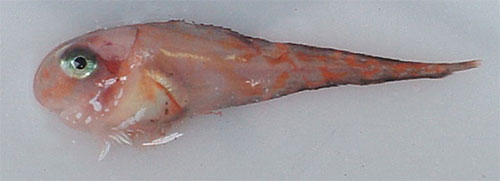
Mischievous Snailfish and Other Mysteries of the DeepBy CHRISTINE BAIER
June 16, 2016
But sometimes they find something no one has seen before. Mischievous, hardheaded, arbiter, dusty, peach, tomato, whiskered, combed, goldeneye, comet and comic snailfishes: none of these species were known to science 10 years ago. Some were named only last year. All were discovered by Alaska Fisheries Science Center biologist Jay Orr during stock assessment surveys in the Aleutian Islands.
The mischievous snailfish, Careproctus faunus
Some 350 snailfish species inhabit marine environments from the Arctic to Antarctic, from tide pools to deep sea – deeper than any other known vertebrate: one snailfish species was recently found swimming nearly 5 miles below the ocean surface. More than 50 species have been identified in the North Pacific; many more exist that are undescribed, and more continue to be discovered. In fact, Orr has collected twelve more unknown species that are now just waiting to be described. A Slippery Fish A snailfish looks a bit like an overweight tadpole. Naked of scales, its body seems gelatinous. Most species have a sucking disc in place of pelvic fins, and use it to attach themselves to rocks or other undersea surfaces. Most snailfish stay close to the bottom, rather than swimming in the water column. Some of these characteristics partly explain why there are still so many unnamed snailfish. “They are challenging for taxonomists,” Orr says. “Because they don’t have scales, they get damaged easily. In the past, biologists might just call all snailfish ‘snailfish,’ instead of attempting to identify them.” Taking advantage of a small bag added to the footrope of the trawl used to collect samples of other fish and invertebrates for species assessment, Orr’s group was able to collect undamaged snailfish, a true rarity. “The first time it was deployed it came up full of snailfish in perfect condition," says Orr. “We aren’t sure why it works, but suspect it creates a vortex that gently sweeps up snailfish. A snailfish looks a bit like an overweight tadpole. Naked of scales, its body seems gelatinous. Most species have a sucking disc in place of pelvic fins, and use it to attach themselves to rocks or other undersea surfaces. Most snailfish stay close to the bottom, rather than swimming in the water column. Some of these characteristics partly explain why there are still so many unnamed snailfish. “They are challenging for taxonomists,” Orr says. “Because they don’t have scales, they get damaged easily. In the past, biologists might just call all snailfish ‘snailfish,’ instead of attempting to identify them.” Taking advantage of a small bag added to the footrope of the trawl used to collect samples of other fish and invertebrates for species assessment, Orr’s group was able to collect undamaged snailfish, a true rarity. “The first time it was deployed it came up full of snailfish in perfect condition," says Orr. “We aren’t sure why it works, but suspect it creates a vortex that gently sweeps up snailfish. Location, Location Orr collects snailfish during fish and invertebrate species assessment cruises in the Aleutian Islands, as well as other regions in Alaska. Many of the new species were found in the Central Aleutians, and had not been identified during routine surveys of the entire Aleutian chain since 1980s. The central Aleutians are a “biological hot spot” because of high productivity and prey availability. Snailfish may be concentrated in this high biodiversity area because of these favorable conditions. Also, they live and lay their eggs on the bottom, which may tend to keep them in this desirable real estate.
The comic snailfish, Careproctus comus
“I name some of them according to what strikes me about the fish, its color or morphology,” says Orr. “I’ve also used descriptive words from the Aleut language, in honor of the Aleut people. And some species are named after individual people.” Prognatholiparis ptychomandibularis, for example, means “protruding jaw snailfish, folded jaw," and is commonly known as the wrinkle-jaw snailfish. The goldeneye snailfish Allocareproctus unangas was named in honor of the Unangas, the Aleut people of Atka Island, near which the species was discovered. The species name for Careproctus lerikimae, the dusty snailfish, is an amalgam of the first names--Libby, Erika, and Kim--of three scientists who helped collect the first specimens. One hardheaded snailfish (Lopholiparis flerxi) was affectionately named after a colleague known for his keen eye for unusual specimens – and for his strong opinions. Two most recently discovered species were named after retired leaders at the Alaska Fisheries Science Center who supported work in fisheries ecosystem management and biodiversity. “And they are just great guys,” says Orr. Orr has not named any species after himself (that’s just not done), but other scientists did: a whole new genus of fossil fishes is named Orrichthys, in honor of Orr’s contributions to the field.
Edited by Mary Kauffman, SitNews
Source of News:
Representations of fact and opinions in comments posted below are solely those of the individual posters and do not represent the opinions of Sitnews.
|
||

